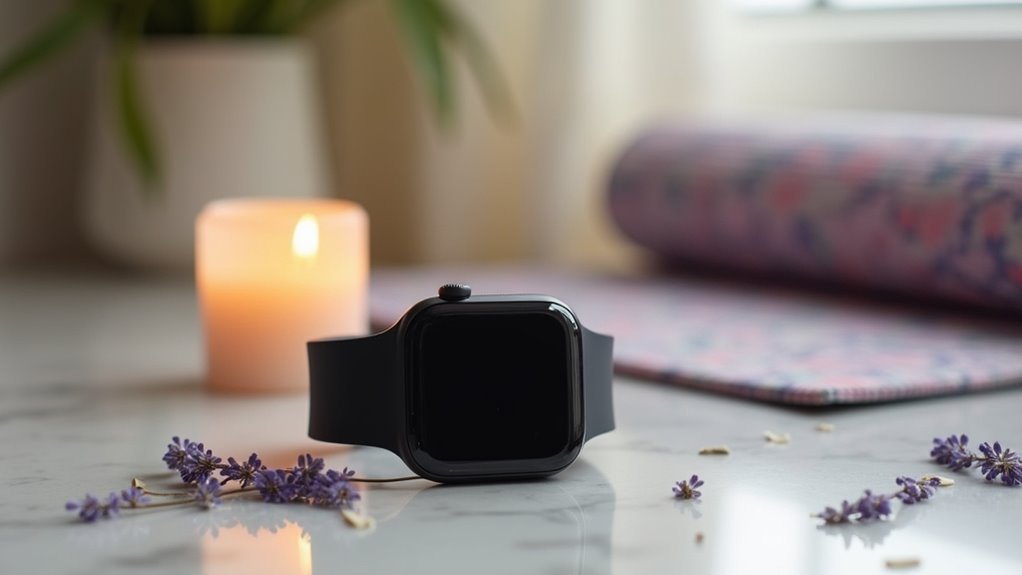You can protect your health data by enabling strong encryption like AES-256 on all devices and using multi-factor authentication for health apps, which prevents 99.9% of account compromises. Configure role-based access controls, regularly audit app permissions quarterly, and scrutinize privacy policies to understand data sharing practices. Enable automatic screen locks, remote wipe capabilities, and guarantee your network uses WPA2 Enterprise security. These foundational steps will shield you from the growing threats targeting medical devices and personal health information.
Understanding Health Data Vulnerabilities in Wearable Devices
Why should you worry about the security of your fitness tracker or glucose monitor when these devices seem so convenient and helpful?
Because approximately 75% of IoT medical devices possess exploitable security weaknesses that put your health data at risk. These vulnerabilities include unpatched software, weak authentication, and unsecured communication protocols that attackers can exploit to manipulate your health metrics.
Three-quarters of IoT medical devices harbor security flaws that expose your health data to manipulation and unauthorized access.
When cybercriminals alter data like your step count or heart rate, it’s not just numbers changing—it’s potentially life-threatening. Inaccurate glucose readings could lead to inappropriate insulin doses, while compromised fitness data might result in incorrect medical decisions. The situation becomes more concerning when you realize that 70% of hospitals have experienced significant ransomware attacks, demonstrating how vulnerable our healthcare infrastructure has become.
Your wearable device can also become an entry point for attackers to infiltrate larger healthcare networks, turning your personal device into a weapon against entire medical systems.
Encryption Standards for Protecting Personal Health Information
You need strong encryption methods to safeguard your personal health information from unauthorized access and data breaches.
Implementing end-to-end data protection guarantees your sensitive medical data remains secure whether it’s stored on devices or transmitted between healthcare providers.
Meeting HIPAA compliance requirements isn’t just about following regulations—it’s about establishing robust encryption standards that protect your privacy and maintain the integrity of your health records. Organizations should adopt AES 256-bit encryption or higher standards rather than relying on outdated minimum requirements to provide maximum protection for electronic protected health information.
Strong Encryption Methods Matter
When healthcare organizations handle your personal health information electronically, they’re required by HIPAA’s Security Rule to implement strong encryption methods that protect your data both when it’s stored and transmitted.
These encryption standards aren’t just technical requirements—they’re your shield against data breaches that could expose your most sensitive medical information. Healthcare providers must use industry-standard encryption like AES with 128-bit keys minimum to safeguard your records.
Encryption is categorized as an addressable requirement under HIPAA, meaning healthcare entities must assess whether encryption is appropriate for their operations and document their rationale if they choose alternative security measures.
Key encryption protections include:
- Data at rest encryption covering servers, mobile devices, and cloud storage
- TLS protocols securing your information during network transmission
- Access controls ensuring only authorized personnel can decrypt your data
- Key management systems protecting encryption keys from unauthorized access
- Regular algorithm updates maintaining cryptographic strength against evolving threats
End-to-End Data Protection
While strong encryption provides essential protection at individual touchpoints, end-to-end data protection creates an unbreakable security chain that shields your health information throughout its entire journey—from the moment it’s created in your doctor’s office to when it’s accessed by specialists, insurance companies, or research facilities.
You’ll want systems using AES-256 encryption for stored data and TLS 1.3 for transmission.
Look for providers implementing Hardware Security Modules (HSMs) for secure key management and regular key rotation protocols. Confirm your healthcare providers conduct continuous monitoring and automated compliance checks.
When selecting services, verify they follow NIST guidelines and maintain proper contractual obligations with third-party vendors. Ensure they perform risk assessments every six months on all locations where your electronic protected health information is stored.
Advanced technologies like blockchain integration and fully homomorphic encryption offer even stronger protection, allowing data analysis without compromising your privacy.
HIPAA Compliance Requirements
Although HIPAA’s Security Rule doesn’t mandate specific encryption protocols, it treats encryption as an “addressable safeguard”—meaning you must either implement it or prove through a thorough risk assessment that alternative measures provide equal protection for your electronic health information.
This flexibility allows you to choose encryption methods that fit your organization’s needs while ensuring ePHI remains secure both at rest and in transit.
Remember, you’re responsible for justifying your security decisions if you opt against encryption.
Key compliance requirements include:
- Conducting extensive risk assessments to determine encryption necessity
- Implementing technical mechanisms for encrypting and decrypting ePHI
- Training staff on encryption procedures and security importance
- Monitoring and maintaining encryption systems regularly
- Documenting alternative protection measures if encryption isn’t used
Healthcare organizations of all sizes must meet these HIPAA encryption requirements to avoid significant penalties that can reach up to $1.5 million per violation.
Recognizing Common Data Breach Attack Vectors
Understanding the landscape of cyber threats targeting healthcare organizations empowers you to better protect sensitive health information.
Hacking represents the most prevalent threat, causing over 90% of compromised health records between 2015-2019 through software vulnerabilities and brute force attacks.
You should recognize phishing emails as another major risk, with 88% of healthcare workers opening these deceptive messages.
These attacks surged 75% in 2021, often targeting employees during peak hours between 7 A.M. and 1 P.M.
Ransomware attacks have quadrupled since 2017, primarily targeting hospitals and encrypting critical data for ransom payments.
Business email compromise has risen 473%, with healthcare organizations receiving an average of 96 fraudulent emails quarterly.
Finally, insider threats remain significant, ranking second after hacking as common breach causes.
The healthcare sector has experienced an upward trend in data breaches, with 2023 setting new records for both total breaches and the number of records compromised.
Implementing Strong Access Controls for Health Apps
You’ll need robust access controls to protect your health app data from unauthorized users who exploit weak security measures.
Start by enabling multi-factor authentication, which adds essential layers of protection beyond simple passwords.
Don’t forget to regularly audit user permissions and configure your device’s security settings to create an all-encompassing defense system.
Consider implementing role-based access control, which limits what different types of users can view and modify based on their specific roles and responsibilities within the healthcare system.
Multi-Factor Authentication Setup
Two critical seconds—that’s how long cybercriminals need to exploit a compromised password and access your health data.
You need multi-factor authentication (MFA) to create multiple barriers between hackers and your sensitive medical information.
MFA requires two or more verification methods before granting access. You’ll combine something you know (password), something you have (smartphone), and something you’re (fingerprint). This layered approach dramatically reduces unauthorized access risks.
Microsoft analysis shows MFA could prevent 99.9% of account compromises, making it essential for protecting your medical records.
Here’s how to implement MFA effectively:
- Choose secure methods: Use authenticator apps or biometrics instead of vulnerable SMS codes
- Enable MFA everywhere: Activate it for all health apps, patient portals, and medical accounts
- Use adaptive settings: Configure triggers for suspicious activity or sensitive data access
- Test regularly: Verify MFA doesn’t disrupt your healthcare workflows
- Stay updated: Review and upgrade your MFA methods as technology evolves
Regular Permission Audits
While MFA protects your health apps from external threats, internal security gaps can expose your data just as dangerously. Regular permission audits help you identify who’s accessing your sensitive health information and why they need it.
You should conduct these audits quarterly or whenever your app undergoes significant changes. Start by cataloging all user accounts and their associated permissions, then verify each person has only the minimum access they need for their role.
Track any permission changes and monitor for suspicious activity patterns. Use automated audit scripts and logging frameworks to streamline this process. Document your findings and address any issues immediately.
These comprehensive assessments are particularly crucial for maintaining HIPAA compliance, as the regulation mandates regular security evaluations for apps handling protected health information.
Device Security Settings
Beyond auditing permissions, your device’s own security settings form the foundation of strong access controls for health applications.
You’ll want to configure these settings properly to create multiple barriers against unauthorized access to your sensitive medical information.
Essential device security settings include:
- Enable device encryption to protect all stored health data from unauthorized access if your device is compromised
- Activate automatic screen locks with PINs, passwords, or biometric authentication to prevent casual snooping
- Turn on remote wipe capabilities so you can erase health data if your device gets lost or stolen
- Configure app-specific locks for health applications requiring additional authentication beyond your device lock
- Enable automatic security updates to guarantee your device receives the latest protection against emerging threats
For apps that handle protected health information, consider implementing multi-factor authentication as an additional security layer, since this robust authentication mechanism provides enhanced protection for your most sensitive medical data.
Managing Third-Party Data Sharing Permissions
Managing your third-party data sharing permissions requires understanding who’s receiving your health information and why they’re getting it. Over 70% of hospitals share data with service providers, marketers, and advertisers for business purposes rather than patient care.
You’ll need to scrutinize privacy policies carefully, though they’re often unclear about these practices.
Take control by requesting transparency from your healthcare providers about their data sharing arrangements. Ask specifically who receives your data and for what purposes. Demand clear disclosure of third-party recipients before consenting to treatment.
Push for dynamic consent options that let you modify permissions as your preferences change. Prioritize providers who use data primarily for improving care rather than commercial gain, and always guarantee any sharing serves your individual healthcare needs first. Hospital websites typically transfer data to a median of nine third-party domains, highlighting the extensive reach of your personal information.
Regular Security Updates and Device Maintenance
You can’t protect your health data without keeping your software current and systems secure.
Software patch management guarantees critical security vulnerabilities get fixed before hackers exploit them, while legacy system updates prevent outdated technology from becoming your weakest link. Healthcare organizations face 275 million compromised records from data breaches in 2024 alone, highlighting the critical importance of maintaining updated systems.
Regular maintenance isn’t just about performance—it’s essential for maintaining the privacy safeguards that protect your sensitive medical information.
Software Patch Management
Countless health data breaches stem from unpatched software vulnerabilities that cybercriminals exploit to access sensitive patient information.
You need a systematic approach to patch management that prioritizes security while maintaining system stability.
Effective patch management requires automation and strategic planning to protect your health data systems:
- Prioritize critical patches first – Address high-risk vulnerabilities immediately to prevent exploitation of sensitive patient data
- Test patches before deployment – Use controlled environments to guarantee updates won’t disrupt healthcare operations
- Automate patch application – Reduce human error and guarantee consistent updates across all systems
- Maintain complete system inventory – Track all devices and software requiring updates
- Schedule updates during maintenance windows – Minimize disruptions to patient care services
Regular audits guarantee you haven’t missed critical security updates. Comprehensive patch management prevents costly breaches by addressing vulnerabilities before cybercriminals can exploit them to compromise patient data.
Legacy System Updates
While modern healthcare systems demand cutting-edge security, many organizations still rely on legacy systems that create dangerous vulnerabilities in their data protection infrastructure.
These outdated systems can’t defend against modern cyber threats, making your health data susceptible to breaches that compromise your privacy and delay treatments.
Legacy systems often lack interoperability, preventing seamless coordination between your healthcare providers.
They’re costly to maintain and frequently don’t meet current regulatory standards, creating compliance risks that affect your care quality. A recent survey revealed that 73% of healthcare providers continue operating with these outdated systems despite known security risks.
You should advocate for your healthcare providers to modernize their systems through phased updates, proper staff training, and adequate budget allocation.
Updated systems offer enhanced security features, improved patient care through better electronic health record access, and increased efficiency that directly benefits your healthcare experience and data protection.
Network Security Best Practices for Health Monitoring
When protecting sensitive health data across digital networks, robust security measures form the foundation of any effective health monitoring system.
You’ll need thorough strategies that address authentication, monitoring, and data protection to maintain HIPAA compliance and safeguard patient information.
Essential network security practices include:
- Implement strong authentication controls – Use unique user IDs, WPA2 Enterprise, and multifactor authentication to verify authorized access.
- Enable continuous network monitoring – Deploy automated alerts and maintain audit trails to detect suspicious activity early.
- Encrypt all health data – Protect information both at rest and in transit using strong encryption protocols and VPNs.
- Segment your networks – Isolate sensitive health monitoring systems from less secure network areas.
- Maintain incident response plans – Establish formal procedures and train staff on cybersecurity best practices. Additionally, ensure all vendor relationships include appropriate business associate agreements that address breach and security incident obligations to protect sensitive data throughout your entire network ecosystem.
Data Storage Location and Cloud Security Considerations
As you evaluate where to store sensitive health data, the location and security architecture of your storage infrastructure becomes critical for maintaining HIPAA compliance and protecting patient privacy.
When using cloud services, you’ll need robust encryption for data both in transit and at rest. Implement multi-factor authentication and role-based access controls to limit data access strictly to authorized personnel.
Ascertain your cloud provider complies with relevant healthcare regulations and regularly updates security software to address vulnerabilities. Use real-time monitoring tools to detect threats immediately.
Verify cloud providers meet healthcare compliance standards and maintain current security patches with continuous threat monitoring capabilities.
For physical data centers, maintain strict access controls, surveillance systems, and segmentation to prevent unauthorized entry and limit attack spread. Implement redundant systems and reliable cooling to guarantee continuous availability while protecting against hardware failures and environmental threats.
Organizations with comprehensive data protection measures can reduce breach costs by 28% compared to those with basic security implementations.
Privacy Settings Configuration for Maximum Protection
Beyond selecting secure storage infrastructure, you must fine-tune privacy settings within your health data systems to create multiple layers of protection. Proper configuration transforms basic security features into robust defense mechanisms that actively prevent unauthorized access.
Your privacy settings should work together as an integrated security framework:
- Audit user permissions regularly to verify access levels match current job responsibilities and remove inactive accounts immediately.
- Enable multi-factor authentication for all users, especially those accessing sensitive data remotely or from mobile devices.
- Configure strong encryption protocols using AES-256 for stored data and TLS 1.3 for data transmission.
- Implement strict device controls with authentication requirements and dedicated networks for medical equipment.
- Schedule automated privacy reviews to apply updates and adjust settings based on emerging threats.
Strong privacy configurations help prevent the costly data breaches that average $2.2 million in the healthcare industry, making proactive security measures a critical investment for any organization handling patient information.
Creating Emergency Response Plans for Data Breaches
Every healthcare organization will eventually face the question of whether they’re truly prepared for a data breach emergency. You’ll need a thorough emergency response plan that activates immediately when breaches occur. Start by assembling your incident response team with IT specialists, legal experts, and communications professionals. You must preserve evidence while containing the breach to prevent further data loss.
Your plan should address legal compliance requirements, including HIPAA and GDPR notifications. Draft clear public statements and establish communication chains before emergencies strike. Organizations with robust incident response teams save approximately 1.2 million compared to less-prepared peers, making preparation a critical investment in your organization’s financial protection.
| Response Phase | Key Actions | Timeline |
|---|---|---|
| Immediate | Activate plan, assemble team | 0-2 hours |
| Containment | Preserve evidence, stop breach | 2-24 hours |
| Investigation | Fix vulnerabilities, investigate | 1-7 days |
| Recovery | Update policies, train staff | Ongoing |
Frequently Asked Questions
How Long Do Healthcare Organizations Typically Keep My Personal Health Data?
Healthcare organizations typically keep your personal health data for at least six years as required by HIPAA, though state laws and medical guidelines may require longer retention periods for certain records.
Can I Request Complete Deletion of My Health Records From Providers?
You can’t typically request complete deletion of your health records. Healthcare providers must retain records for legal compliance, patient safety, and continuity of care, though you can request corrections to inaccurate information.
What Legal Rights Do I Have After My Health Data Is Breached?
You have the right to breach notification, can seek legal redress through lawsuits, may join class action suits, and can pursue damages for negligence if your healthcare provider failed securing your data properly.
How Can I Monitor if My Health Information Is Being Sold?
You can monitor unexpected targeted health ads, check for unsolicited medical marketing, review credit reports for anomalies, use privacy monitoring apps, and request disclosure records from healthcare providers under HIPAA.
Are Genetic Testing Companies Required to Follow HIPAA Privacy Rules?
Most genetic testing companies aren’t required to follow HIPAA because they’re not covered entities. However, they must comply when sharing your results with healthcare providers and follow various state privacy laws.





Leave a Reply